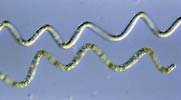
[ Q ] Spirulina: What is it and where does it come from?

-
Spirulina is a microscopic freshwater plant that grows in America, Mexico and Central Africa. It naturally grows in warm water and alkaline volcanic lakes, but is hydroponically grown around the world for human use.
 |
||
 |
What Does Hydroponically Mean? Hydroponics means growing plants in nutrient-rich water, without soil. With hydroponics, there are no soil-borne diseases, weeds to pull, or soil to till, and plants can be placed very close together. This allows a large amount of food to be produced in a small amount of space. Hydroponics is also very water-efficient as it uses containers or closed loop systems that recirculate the water, and therefore requires only a small fraction of the water used in traditional farming. Many plants can produce more food in less time using this method. Plants can thus be grown in artificial environments in places where plants would otherwise not grow. |
 |
 |
||
Spirulina contains over one hundred vitamins and minerals, and is rich in beta-carotene, iron, vitamin E, B-12, chlorophyll, phytonutrients, and GLA - a rare essential fatty acid. The Aztec peoples used spirulina for hundreds of years.
 |
Aztecs: In Nahuatl, the native language of the Aztecs, "Aztec" means "someone who comes from Aztlán, the place of the cranes", a mythical place in northern Mexico. The Aztec, however, referred to themselves as Mexica or Tenochca. The modern usage of the name Aztec as a collective term, applied to all the peoples linked by trade, custom, religion, and language to the Mexica state, the Triple Alliance, was suggested by Alexander von Humboldt. |
 |
 |
||

[ Q ] What does it do and what scientific studies support this?
-
The effects of
spirulina are established by science.
Spirulina has been shown to inhibit some strains of viral replication1, can help control the herpes simplex virus2, and has shown promise in the treatment of HIV-1, HSV-1, HCM infections and AIDS.3
Best of all, it is effective in treating HIV-1 while being non-toxic to human cells.4 Spirulina also boosts immune system function.5, 6, 7, 8 by helping the body develop new blood cells, enhancing bone marrow, macrophage, t-cell and natural killer cell function.
 |
||
 |
What Is A Macrophage? Macrophages are cells found in the body that are responsible for the elimination of disease-causing germs (such as microorganisms, viruses, toxins, bacteria, and fungi), as well as dead cells and cellular debris. |
 |
 |
||
Aside from its ability to inhibit viral and bacterial growth (by preventing the virus from penetrating the cell wall), spirulina inhibits tumor growth9 and can act as an anti-inflammatory, thus easing the symptoms of arthritis.
Anecdotal evidence suggests that spirulina may be useful for weight control and obesity treatment.10 It can increase the function and quality of beneficial microflora (thus increasing digestive efficiency), reduce cholesterol levels11, 12, 13, 14 and its mineral and vitamin content can help control appetite. Spirulina also detoxifies the body.15

[ Q ] Who needs it and what are some symptoms of deficiency?
-
Everyone can benefit from spirulina supplementation because of its beneficial effects on immune function.
Those with weakened immune systems can benefit from the immuno-protective effects of spirulina. Hard training athletes can especially benefit from using spirulina as they are susceptible to the effects of over-training.
Spirulina can enhance recovery from exercise and maintain immune system integrity; this may boost athletic performance.
Vegetarians are at risk for being iron deficient and can benefit from spirulina supplementation because of its iron content.
Spirulina is not an essential nutrient and no symptoms of deficiency exist.

[ Q ] How much should be taken? Are there any side effects?
-
Strictly adhere to label directions.
Consult with a physician prior to use.
References
- Calcium Spirulan, an inhibitor of enveloped virus replication, from a blue-green alga Spirulina. by Hayashi et al. 1996. Pub. in Journal of Natural Products, 59, 83-87. Japan.
- An extract from spirulina is a selective inhibitor of herpes simplex virus Type 1. by Hayashi et al. 1993. Japan.
- Hayashi T. & Hayashi K., et al, Journal of Natural Products 1996, Vol. 59, No. 1, 83-87, American Chemical Society and American Society of Pharmacognosy. Calcium Spirulan, an Inhibitor of Enveloped Virus Replication, from a Blue-Green Alga Spirulina platensis.
- Inhibition of HIV-1 replication by an aqueous extract of spirulina. by Ayehunie, Belay et al. 7th IAAA Conf., Knysna, South Africa. 1996. USA.
- Ability of spirulina carotenes in preschool children. by V. Annapurna, et al. 1991. National Institute of Nutrition, Hyderabad, India. J. Clin. Biochem Nutrition. 10 145-151. India.
- Phagocytic potential of feline macrophages after exposure to a water soluble extract of spirulina in vitro. by M. Qureshi, et al. January 1996. Pub. in Immunopharmacology. in press. USA.
- Immune enhancement potential of spirulina in chickens. by M. Quereshi, et al. August 1994. Poultry Science Assoc. Dept. of Poultry Science, North Carolina State, NC. Pub. in Journal of Poultry Science Vol 73, S.1. p. 46. USA.
- Qureshi M.A., Garlich J.D., Kidd M.T., Immunopharmacology and Immunotoxicology, 1996 (submitted), "Dietary Spirulina platensis Enhances Humoral and Cell-mediated Immune Functions In Chickens".
- Inhibitive effect and mechanism of polysaccharide of spirulina on transplanted tumor cells in mice. by Lisheng, et al. 1991. Pub. in Marine Sciences, Qingdao, N.5. pp 33-38. China.
- Clinical and biochemical evaluations of spirulina with regard to its application in the treatment of obesity. by E.W. Becker, et al. 1986. Inst. Chem. Pfanz. Pub. in Nutrition Reports Int'l, Vol. 33, No. 4, pg 565. Germany.
- Iwata K, Inayama T, Kato T. Effects of Spirulina platensis on plasma lipoprotein lipase activity in fructose-induced hyperlipidemic rats. J Nutr Sci Vitaminol (Tokyo) 1990;36:165-71.
- Nakaya N, Homma Y, Goto Y. Cholesterol lowering effect of Spirulina. Nutr Rep Int 1988;37:1329-37.
- Cholesterol lowering effect of spirulina. by N. Nayaka, et al. 1988. Tokai Univ. Pub. in Nutrition Reports Int'l, Vol. 37, No. 6, 1329-1337. Japan.
- The effect of spirulina on reduction of serum cholesterol. by N. Nayaka, et al. 1986. Tokai Univ. Pub. in Progress in Medicine, Vol. 36, No. 11. Japan.
- Effect of spirulina on the renal toxicity induced by inorganic mercury and cisplatin. by H. Fukino, et al. 1990. Pub. in Eisei Kagaku, 36:5, 1990. Japan.


